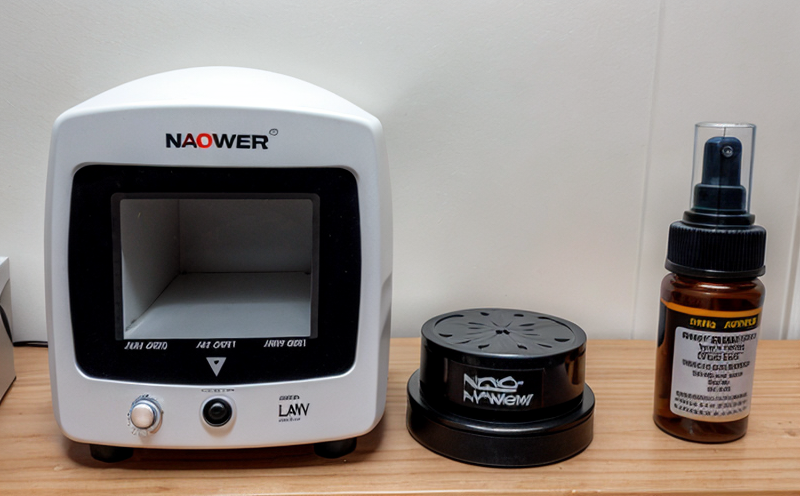ASTM E1521 Small Angle X Ray Scattering for Nanoparticle Powders
The ASTM E1521 standard provides a method for determining the size distribution and shape of nanoparticles in powders using small angle X-ray scattering (SAXS). This technique is crucial for understanding the physical characteristics of nanomaterials, which are widely used in various sectors including electronics, pharmaceuticals, and environmental technologies. SAXS allows for non-destructive analysis of nanoparticle sizes down to approximately 1 nm, making it a valuable tool for quality control and research.
The testing process involves several key steps that ensure accurate results. Initially, the sample must be prepared by dispersing the nanoparticles in an appropriate solvent, such as water or ethanol, to avoid agglomeration. The solvent should not interfere with the scattering of X-rays. After dispersion, the sample is placed in the SAXS instrument and exposed to a monochromatic X-ray beam. The scattered X-rays are detected and analyzed using specialized software that can interpret the data into size distribution curves.
The ASTM E1521 method specifies detailed procedures for both sample preparation and instrumental calibration, ensuring consistency across different laboratories. This standardization is critical for maintaining accuracy and reproducibility in nanoparticle research and development. The technique's ability to provide precise measurements of particle sizes down to nanometers makes it indispensable for industries that rely on the unique properties of nanoparticles.
In addition to size distribution, SAXS can also reveal information about the shape and orientation of particles within a powder sample. This additional data is particularly useful in fields like materials science where understanding the morphology of nanoparticles can influence their performance in composite materials or drug delivery systems. By providing detailed insights into nanoparticle characteristics, ASTM E1521 supports industries in optimizing product formulations and ensuring compliance with regulatory standards.
The importance of ASTM E1521 extends beyond just analytical capabilities; it also plays a role in advancing the broader understanding of nanotechnology. As researchers continue to explore new applications for nanoparticles, having reliable methods like SAXS becomes increasingly important. This ensures that any innovations based on nanoparticle properties are built upon solid scientific foundations.
To summarize, ASTM E1521 provides an essential tool for characterizing nanoparticle powders through small angle X-ray scattering. Its precise measurements and standardized procedures enable accurate assessment of particle sizes, distributions, and shapes, which are critical parameters in many industries. By leveraging this method, laboratories can contribute significantly to the advancement of nanotechnology while ensuring high-quality products.
Benefits
- Precision Measurement: ASTM E1521 allows for highly accurate determinations of nanoparticle sizes, enabling precise control over manufacturing processes and product quality.
- Compliance Assurance: This method ensures that nanomaterials meet regulatory requirements, thereby reducing the risk of non-compliance issues.
- Research Support: By providing detailed insights into nanoparticle characteristics, ASTM E1521 facilitates advancements in various scientific fields, including materials science and pharmaceuticals.
- Process Optimization: Understanding particle size distribution helps optimize production methods, leading to more efficient processes and better end products.
- Quality Control: Regular use of SAXS through ASTM E1521 ensures consistent product quality across batches, enhancing customer satisfaction and brand reputation.
- Risk Mitigation: Early detection of potential issues in nanoparticle properties can prevent costly rework or recalls downstream.
International Acceptance and Recognition
The ASTM E1521 standard has gained widespread recognition across the international community, with numerous countries adopting it for their own national standards. Its acceptance is particularly notable in regions like Europe, where nanotechnology is a key focus of research and development. Organizations such as the European Committee for Standardization (CEN) have endorsed ASTM E1521 as a basis for national testing protocols.
International collaboration in nanotechnology has led to increased standardization efforts, with ASTM E1521 serving as a cornerstone in these endeavors. Laboratories from diverse backgrounds rely on this method due to its robustness and reliability across different environments and facilities. The harmonization of standards facilitated by ASTM E1521 helps reduce barriers to trade and innovation within the global nanotechnology sector.
The growing recognition of ASTM E1521 reflects its significance in fostering a standardized approach to nanoparticle characterization, which is vital for both academic research and industrial applications. By aligning with international standards, laboratories can ensure their results are comparable and validated by peers around the world.
Environmental and Sustainability Contributions
The study of nanomaterials through ASTM E1521 not only benefits immediate industrial applications but also contributes to environmental sustainability. Nanoparticles, when used responsibly and effectively, can lead to more efficient resource utilization and reduced waste generation in manufacturing processes. For instance, optimized particle size distributions can enhance catalytic performances, leading to lower energy consumption and emissions.
Moreover, understanding the behavior of nanoparticles at various scales allows for better management strategies regarding their environmental impact. This knowledge is crucial for developing safer handling protocols and minimizing risks associated with accidental releases into ecosystems. ASTM E1521 supports these efforts by providing clear guidelines on how to assess nanoparticle properties accurately, which in turn aids in informed decision-making.
The standard also plays a role in promoting sustainable practices within the laboratory setting itself. By ensuring that testing methods are efficient and reliable, it helps reduce unnecessary sample usage and promotes the use of non-toxic solvents where possible. These initiatives contribute to minimizing the overall environmental footprint of nanotechnology research and development activities.
In conclusion, ASTM E1521's contributions extend beyond mere analytical capabilities; they include significant implications for environmental sustainability. Through its rigorous standards and harmonized approaches, this method helps pave the way towards more responsible and sustainable practices in nanomaterials science.





